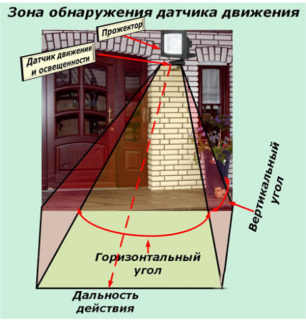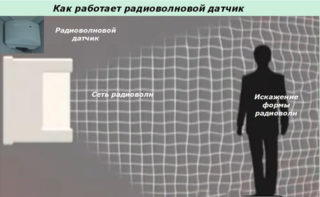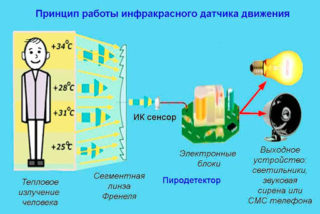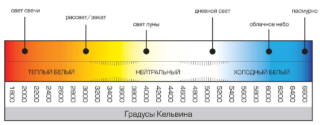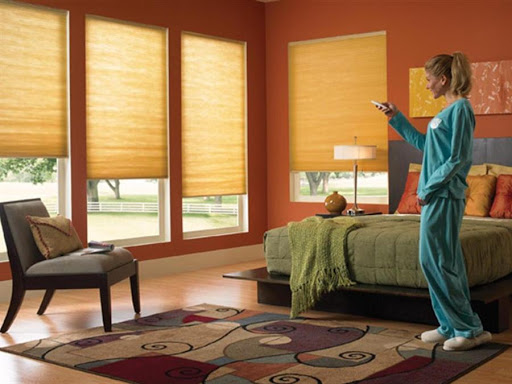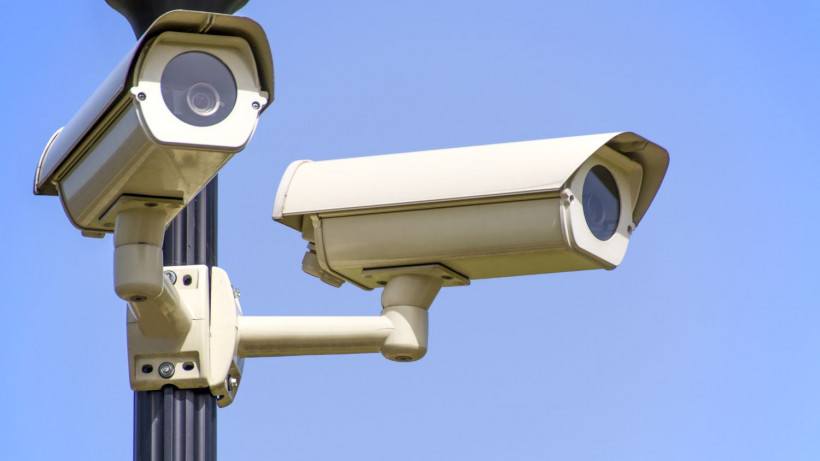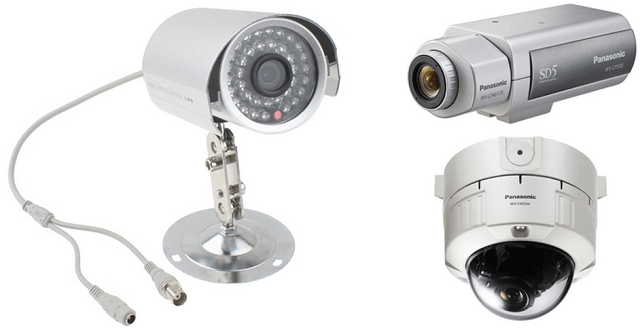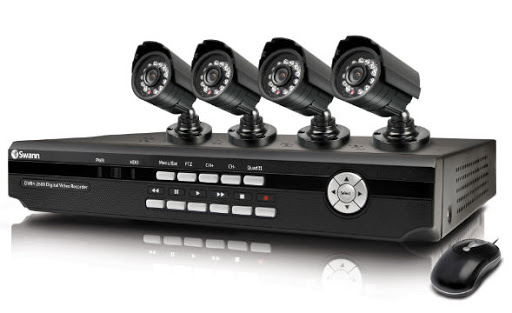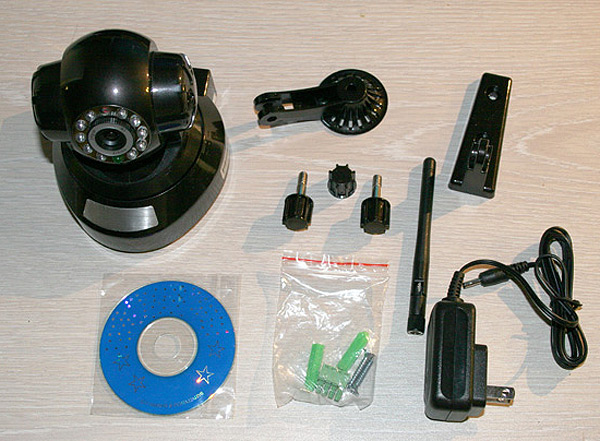High-quality lighting of the local area and industrial sites is an important factor in ensuring safety and a comfortable stay. LED floodlight with motion sensor is a reliable and economical option for organizing lighting. The choice of the model depends on the tasks and features of the object.
Device assignment
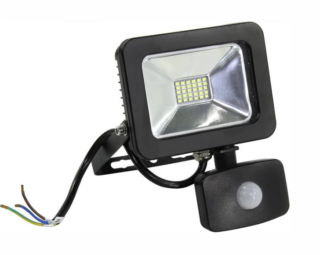
A searchlight with a motion sensor is designed to illuminate the surrounding area at the time of being in the area of action of a person or a group of people. After leaving the detection zone, the device turns off.
Common installation locations for LED luminaires:
- the territory adjacent to the residential building, summer cottages;
- bridges, tunnels, pedestrian crossings;
- parking lots and advertising banners;
- entrances to residential, public and office buildings;
- warehouses.
Do not use floodlights with sensors in the work area - a switched off lamp can cause industrial injuries.
Installation of lanterns with a motion sensor in places of permanent residence of people is impractical.
Equipment composition and principle of operation
- power supply for LED and sensor;
- LED matrix or separate LED;
- Motion Sensor;
- adjustable turn-off delay circuit;
- light sensor.
The algorithm of the searchlight is that power is supplied to the LEDs only when people or moving equipment appear in the detection area. The delay unit will turn off the power after a predetermined time after the cessation of the movement of people (vehicle passage). The light sensor blocks the operation of the device during daylight hours in order to exclude "unnecessary" on-off cycles.
The motion detector can be in the same housing with the luminaire or be remote.
Sensor types
Radio waves sensors are mainly used in outdoor luminaires. These devices are of the active type.
Microwave waves are emitted into space. The rays reflected from stationary objects return to the device with the same frequency. If the wave is reflected from a moving object, the frequency of the "returned" waves will differ from the emitted ones. The device monitors the change and, when a phenomenon is detected, supplies power to the LEDs.
Advantages of radio wave sensors:
- stable work regardless of the season;
- absence of false inclusions in case of gusts of wind and draft.
The disadvantage is the susceptibility to unnecessary alarms when working in an area of strong electromagnetic interference from powerful electrical equipment.
In the heat, when the body temperature is close to the surrounding objects, the sensor does not always see the difference; the LEDs turn on intermittently.The same phenomenon occurs in winter, when a person is wearing warm clothes, the surface of which does not strongly contrast with the surrounding environment. Luminaires with infrared sensors are more suitable for enclosed spaces or small courtyards.
Sound the sensors react to the generated noise, the source of which may be footsteps or quiet conversation Floodlights with this type of detector are better suited for enclosed spaces. For street lamps, the signal can be the sounds of a car passing in the distance or an airplane flying by.
Type of food
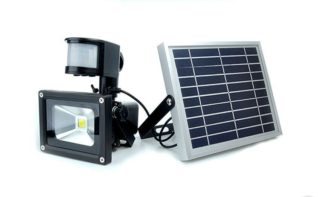
There are three types of devices according to the type of power supply:
- operating from a direct or alternating current network;
- wireless with built-in rechargeable batteries;
- powered by batteries rechargeable from solar cells.
The first type is common in private homes and businesses. A 220 V household network or voltage from power supplies is used. Installation of backup power supplies will allow using the device during short-term power outages.
The built-in batteries will need to be recharged regularly, so it is best to choose lights that are easy to dismantle and install after charging. The motion sensor allows you to save power by turning on the device for a short time.
The most independent from the network are floodlights with a motion sensor, powered by a solar battery. Such sensors are not installed in places where frequent switching on of the flashlight is possible - in winter, the battery life will not be enough for the entire dark period of the day. Often such lights can be seen at pedestrian crossings outside settlements.
Advantages and disadvantages

Economical and bright LEDs controlled by motion sensors make the floodlights desirable in many applications. The popularity is due to the features of such lighting equipment:
- a wide range of places where spotlights are in demand;
- reliability and durability - LEDs are much more stable than halogen and incandescent lamps in conditions of regular on-off cycles;
- low cost, comparable to lamps equipped with halogen lamps;
- energy saving due to LEDs and switching on for a short period as needed;
- high luminous efficiency per watt of power consumption;
- wide range of operating temperatures;
- automatic switching on without the use of switching equipment, which is important based on compliance with safety measures in outdoor conditions;
- battery-powered due to low power consumption.
The wrong choice of the type of detector and the orientation in space can be the reasons for frequent switching on, which quickly leads to the failure of the LED matrix. Pets can cause false positives.
For work areas, it is necessary to duplicate lighting, since with minor movements of a person, the searchlight can go out, which is unacceptable during work, and is fraught with injuries.
Criterias of choice
When buying, they are guided by the consumer properties and technical characteristics of the floodlight, which include:
- safety of use;
- permissible operating conditions;
- efficiency parameters;
- power and required illumination in the area of operation of the device;
- viewing angle and color temperature.
An incorrectly chosen flashlight will cause more worries and will irritate the user with the wrong work.
Protection class
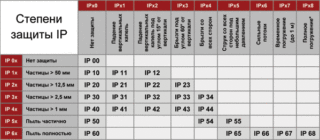
The protection class is indicated by the abbreviation IP-XX, where the first number indicates the degree of protection against solid particles, the second indicates the ability to resist the penetration of moisture and water.
For floodlights used in outdoor conditions without visors and awnings, the first number in the designation cannot be less than 5, the second less than 4.
If the IP value is less than 54, the luminaire will fail after the second or third rain, and the board and glass will be covered with dust.
Body material
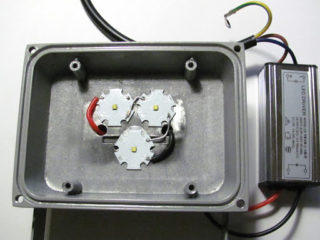
Cheap models are made in plastic cases. This design is not suitable for floodlights with power over 10 W. LEDs need high-quality heat dissipation, so it is preferable to choose products with a metal case. Most often, silumin compositions are used in production.
Plastic is prone to cracking, loss of plasticity from direct sunlight, therefore, it is not suitable for open areas. Such floodlights can be used for short-term switching on in closed rooms.
When buying a flashlight in a plastic case, you need to make sure that the LED matrix (LED) is located on a massive heatsink.
For floodlights with metal housings, you can temporarily disable the motion sensor for the period of work or when receiving guests. It is impossible to use the constant glow mode in plastic lamps.
Power and efficiency

The power directly depends on the required dimensions of the illuminated area.
In households, floodlights with a power of 20 to 140 W are most in demand, lamps of 150–250 W are suitable for industrial facilities.
The economy depends on the power consumption and the correctly configured motion sensor. Excessively selected period before shutdown contributes to unnecessary power consumption and rapid battery discharge in wireless luminaires.
In most models, the time before switching off after the last recorded movement can be selected in the range from 15 seconds to 1.5 minutes, sometimes up to 10 minutes. This is enough to overcome an unlit area or open a gate door.
The supply voltage is usually in the range of 180-240 V, as provided by GOST.
Radiation temperature
Industrial floodlights are produced with temperatures from 2700 to 6500 Kelvin. The higher the number, the lighter the color of the radiation will be.
The choice depends on the preferences of the user, but it is better to stop at luminaires with a parameter from 3500 to 5500 K.
It is worth checking the glow on the stand in the store, or asking your neighbors if they have already installed a spotlight.
Field of view
LED arrays can provide horizontal and vertical illumination from different angles. The larger the angle, the whiter a powerful flashlight will be required.
They are guided by specific conditions at the facility. A beam that is too narrow leaves invisible areas near and far from the spotlight.
Before buying, you should draw a picture to scale to the real dimensions of the house and plot and roughly calculate the required lighting angles in the horizontal and vertical planes.
Installation of the luminaire
Depending on the power of the searchlight, the cross-section of the supply wire is selected. For most LED models, a 0.5 mm² cable is sufficient. Number of cores 2. If the existing wiring allows grounding, purchase a 3-core wire.
Power is connected from the nearest junction box or outlet. If necessary, draw a line from the switchboard. It is important to be able to turn off the power for maintenance.
The installation is carried out on a hard surface that excludes vibration from the wind or passing vehicles. On the walls, the wire is carried in a corrugated pipe, which is fixed every 50–70 cm. The cable is laid by air or underground to the posts or fences.
Wire marking must comply with the standard:
- blue or black - working zero, connected to the terminal marked "0" or "N";
- red, white or brown - the phase marked "F" or "L";
- yellow-green - ground.
External sensors are connected according to the instructions.
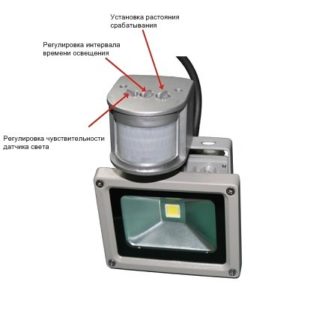
After installation and test run, the motion sensor is adjusted. Some of the spotlights allow you to adjust the detection area of the sensor regardless of the direction of the beam, which allows you to select such a switching mode when a person has not yet entered the lighting area.
With the onset of dusk, the light sensor threshold is adjusted. As a rule, the adjustment knob is marked with the words "DayLigh". The "Time" control sets the on time. The “Sens” knob is needed to adjust the sensitivity. By setting the threshold, the range of the sensor is adjusted, or the device is roughened so that the light does not turn on from the movement of pets. There is no adjustment on the cheaper models.
If necessary, connect the searchlight through a separate switch or machine. This will allow you to operate the device in manual mode.
The best manufacturers and models
Most of the market was occupied by floodlights from several companies.
Manufacturers and reliable models of luminaires with motion sensors for household use:
- WOLTA, Germany, WOLTA WFL-05 series with power 10, 20, 30 and 50 W;
- NAVIGATOR, Russia, production in Klin, NFL-M series;
- GAUSS, Russia, Gauss Elementary series;
- NANOSVET, Russia, part of production is located in China: FAD series;
- FERON, Russia, SEN series;
- Falcon, China, Falcon Eye series.
Installing LED floodlights with motion sensors is an easy way to get an illuminated space while saving money on your electricity bills. Installation and adjustment are available to any real estate owner who has basic skills in working with power grids.

